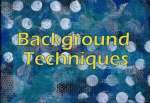 While searching through Blogland, I saw a mention about a new technique featured in the latest issue of Techniques Junkies called ‘The Van Gogh Technique’.
While searching through Blogland, I saw a mention about a new technique featured in the latest issue of Techniques Junkies called ‘The Van Gogh Technique’.
Sadly I dont subscribe to that newsletter because I cant afford it so I didnt know what this technique was about. But not to be outdone, I decided to google for artwork using this technique so I could see what all the fuss was about and work out how its done.
Vincent Van Gogh is particulary famous for his unique painting style, if you look at any one of his paintings you’ll see what really makes his art really stand apart is how you can see every single brush stroke and movement in the painting. He was a genius, certainly ahead of his time and misunderstood.
The Van Gogh Technique takes on the basic principles of Vincents work by re-creating a feeling of movement within a stamped image by adding little scratches or dots of colour using pens to give it a 3 dimensional feel.
So instead of colouring in your stamped image ‘flat’ by using only one colour, with The Van Gogh technique you use more than one colour to create a free style pattern which resembles a flowing movement.
The technique is pretty straightforward, all you need is a stamped image and a couple of marker pens. It works best on images of ‘things’ rather than people, so flowers, fruits and other still life images are perfect. Ive seen it done on people but I dont like the effect Ive seen so far as the people look as if they’ve got a bad rash!
I think your supposed to use marker pens for this technique, but to be honest there are no rules in art! So theres nothing to stop you recreating this technique using your gel pens or coloured pencils for that matter, adapt and use whatever you have to hand.
Anyway heres my take on the technique and how I did it based on the pictures I found online:
Creating The Van Gogh Effect:
The sun image below was stamped on watercolour paper using a blend of yellow and orange acrylic paints, its a large foam stamp which Ive been itching to use for a while, since summer is here at last I was inspired to use it 🙂
Once the stamped image had dried I went over the top with blue goache paint to give it a background wash to resemble the sky and let that dry.
Heres the image I worked on before I started attacking it with my pens:

To create the Van Gogh effect, I took 2 gel pens – one was a signo pastel orange and the other a sakura glittery orange.
Using these 2 pens I added little lines and scribbles all over the face of the sun. I used the lighter pastel pen on the left hand side of the suns face and the glittery pen I used on the right hand side of the face.
For the sky I used a pale blue signo gel pen and added marks all over the background untill Id finished the entire piece.
To finish the picture I got out my black marker and added a border and outlined the sun image to make it pop, heres what the finished piece looks like below:

Another photo of the same piece – I took this one because the glittery pen reflected back on the flash of my camera so you could see how it looks in a different light:

See the photographs below for close up shots so you can see for yourselves (if you click on the pictures you can see them bigger)



For reference heres a couple of the links I found of other artwork while looking to see what the technique was:
http://www.stampqueen.blogspot.com/
http://www.splitcoaststampers.com/gallery/photo/1377784?limit=last1
http://starvingartistampsgallery.blogspot.com/2009/06/van-gogh-contest-still-time-to-enter.html
http://ibrakeforstamps.blogspot.com/2009/06/large-daisy-with-eye.html































 These pocket cards are great for RAKS or for a small Christmas Gift as they feature a handy little pocket on the front of the card which is handy to slip inside a handmade bookmark, tag, magnet or even a shopping voucher from your recipients favourite stamp store!
These pocket cards are great for RAKS or for a small Christmas Gift as they feature a handy little pocket on the front of the card which is handy to slip inside a handmade bookmark, tag, magnet or even a shopping voucher from your recipients favourite stamp store!






















